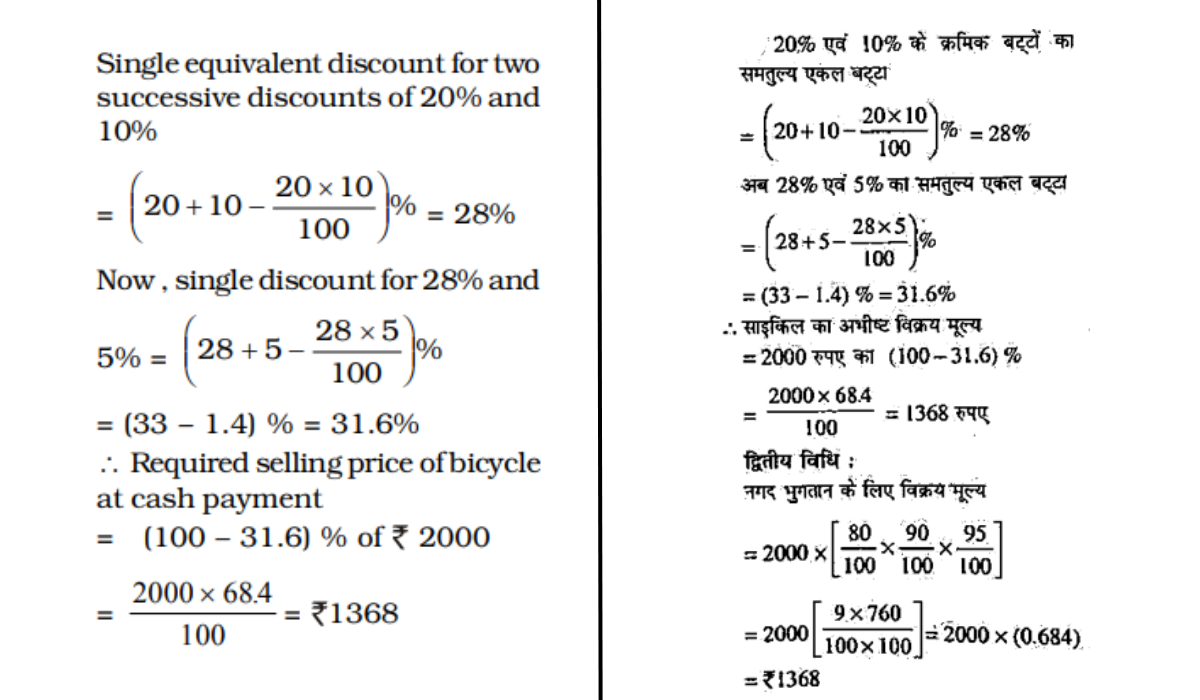Discount Questions Practice Question and Answer
8 Q: Successive discounts of 10% and 30% are equivalent to a single discount of :
625 0624d4e4367b2505d7e56c212
624d4e4367b2505d7e56c212- 138%false
- 237%true
- 340%false
- 435%false
- Show Answer
- Workspace
- SingleChoice
Answer : 2. "37%"
Explanation :

Q: A trader buys a hand watch for Rs.450 and determines its marked price in such a way that even after allowing a discount of 10% on that watch, he makes a profit of 20%. What is the marked price of the watch?
625 06322942c69fe1d77bc067b41
6322942c69fe1d77bc067b41- 1500false
- 2600true
- 3800false
- 4750false
- Show Answer
- Workspace
- SingleChoice
Answer : 2. "600"
Q: The marked price of a watch is ₹ 1000. A retailer buys it at ₹ 810 after getting two successive discounts of 10% and another rate which is illegible. What is the second discount rate?
612 0624d4e92e6c50b4b29d6ca46
624d4e92e6c50b4b29d6ca46- 18%false
- 26.5%false
- 315%false
- 410%true
- Show Answer
- Workspace
- SingleChoice
Answer : 4. "10% "
Explanation :

Q: An item is marked for ₹ 240 for sale. If two successive discounts of 10% and 5% are allowed on the sale price, the selling price of the article will be
602 0624d526967b2505d7e56ed67
624d526967b2505d7e56ed67- 1₹ 34.80false
- 2₹ 36false
- 3₹ 205.20true
- 4₹ 204false
- Show Answer
- Workspace
- SingleChoice
Answer : 3. "₹ 205.20 "
Explanation :

Q: When a shopkeeper gives 10% discount on the list price of a toy, his gain is 20%. If he had given a discount of 20%, his percentage of gain would have been
598 0643e7944a16c2dfa9cf1f84d
643e7944a16c2dfa9cf1f84d- 1true
- 2false
- 310%false
- 415%false
- Show Answer
- Workspace
- SingleChoice
Answer : 1. "
Q: The marked price of a watch is 800. A shopkeeper gives two successive discounts and sells the watch at 612. If the first discount is 10%, the second discount is:
594 0624d54686dc29f5ccd0e76a8
624d54686dc29f5ccd0e76a8- 115%true
- 220%false
- 310%false
- 412%false
- Show Answer
- Workspace
- SingleChoice
Answer : 1. "15% "
Explanation :

Q: A bicycle, marked at ₹ 2,000 is sold with two successive discount of 20% and 10%. An additional discount of 5% is offered for cash payment. The selling price of the bicycle at cash payment is
593 0643e77a82d621da1169a2afb
643e77a82d621da1169a2afb- 1₹1,368true
- 2₹1,468false
- 3₹ 1,568false
- 4₹1,668false
- Show Answer
- Workspace
- SingleChoice
Answer : 1. "₹1,368 "
Explanation :

Q: Naman got 32% discount on the marked price of a car and paid Rs. 153000 for the car. If the discount be 5%, what will be the, cost of car ?
593 0630db28c4e3bf85cbe73b97d
630db28c4e3bf85cbe73b97d- 1Rs. 217350false
- 2Rs.227550false
- 3Rs. 223750false
- 4None of thesetrue
- Show Answer
- Workspace
- SingleChoice

